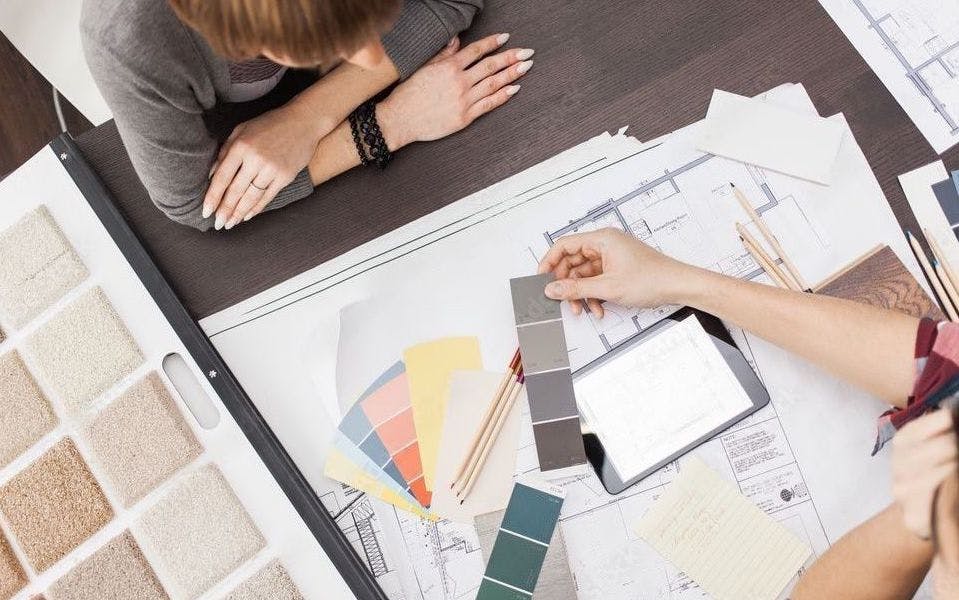How Pros Are Pricing Their Services & Reassessing Fees in 2022
Find out how and why designers are revisiting their pricing methods and rates

If deciding how to charge for your interior design work and knowing when to revisit your fees does not top your list of favorite tasks, read on.
Choosing a pricing model that keeps your business profitable, is equitable to you and your clients, and is dynamic enough to shift with market changes is, of course, one of the most important steps you will take as a professional designer.

Mixing things up in 2022
And in 2022 as inflation, an uncertain economy and shortage of supply and labor puts more pressure on the cost and time it takes to complete their projects, pros are reassessing their fees more frequently.
In this article, experienced design pros from across the country tell us how they are pricing their services in today’s environment to thrive and grow.
Most interior design professionals prefer one of three common pricing structures: Hourly Rate, Lump Sum (Fixed Rate) or Cost Plus - and we dissect the pros and cons of all three in the section below.

Dusting off an old stand by
For Oklahoma-based Kirby Foster Hurd, charging an hourly rate has been her go-to for many years, but now she is watching it more closely. She used to set the rate and forget it, reviewing it only every few years. Then, last year when the owner of Kirby Home Designs noticed that the cost of business was sky-rocketing, she upped her hourly fee by $25 to reflect that.
Going forward she plans to review the rate annually and expects another increase at the end of 2022. “This is an important year to reassess fees more than ever before,” she advises. “The cost of doing business is much greater than it ever has been. For example, gas is more expensive so every mile you drive costs you more than before.”
Her experience is an example of why interior designers should not be shy about charging enough to ensure they are fairly paid for their work. “I still have continued to receive more business this year even with the hourly cost increase.”
As she is starting to add staff and growing her interior design business, Melissa Fields, of Shades of Gray Design Studio in San Antonio Texas has changed to charging a flat fee, which she recently raised. “Inflation and the uncertainty of the economy have been the main drivers for me,” says Fields, owner of the boutique design firm. “Prices for material, products and labor continue to go up so I have to make sure my prices reflect that, otherwise I would be losing money.”

How do you decide what model works for you, and whether it is time to make a switch? Here are some factors to consider in making your choice.
Charging for interior design by the hour
A popular and straightforward choice, charging an hourly rate provides clarity on the time spent on a project for both yourself and your clients.
“At the end of the day, it’s my skill and it’s my hours that you’re getting, regardless of whether I’m shopping, designing, consulting or doing whatever for the project,” says Jeannine Burnett of Access Design + Build. “It’s still my time, and my hourly rate shows this is how much my time is worth.”
However, some find the paperwork and tracking daunting, especially as most designers are juggling multiple projects. Many professionals turn to business management solutions Houzz Pro which includes tools for time tracking, billing and automated change order templates.
Here’s a checklist of factors to consider about charging for interior design services by the hour:
Benefits:
- Provides clarity to both you and the client
- Covers delay costs
- Incentivizes clients to make decisions faster
Risks:
- Clients may feel nickel and dimed
- Carries a significant administrative burden
- 100% accuracy in time tracking is challenging to achieve
Learn more here about charging an hourly rate and how to calculate it.

Setting a Fixed Fee
Since fixed-rate pricing (also known as lump sum) considers the total time it will take to complete a project, making the calculations can get tricky because some costs are hard to predict such as inflationary price increases or delays caused by supply chain issues or higher-maintenance clients.
Kaitlyn Wolfe of Iconic Design + Build prefers the fixed rate method for her design service, but on the construction side, her firm uses a cost-plus approach. Here’s her tips for how to calculate a fee: “I recommend you work out a fair hourly rate and think about the project in phases, estimate your hours for each phase, do the multiplication, and that’ll be your fixed fee.”
The Scottsdale designer has learned that customers understand increases in rates are necessary as long as you are conveying the worth you bring to them. “Clients are willing to pay for high quality, professional design,'' she says. “It’s all about showing the value we are going to bring to the project as well as our fresh, unique aesthetic.”
Wolfe reassesses her growing firm’s fee structure twice a year. “The demand for designers is very high but our time is very limited! We have clients that really want to work with us so they are open to paying more for our team,” she says.
As for the more uncertain human factor: How often you will be contacted on evenings and weekends, designers such as Ellen Z. Wright, owner of Apartment Rehab NYC Interior Design, manages client anxiety through the Houzz Pro Timeline and Daily Log in the Client Dashboard. There, clients can view the project timeline, and leave messages no matter the time of day or night. “They aren’t calling me at two in the morning, they are leaving the message in the dashboard,” says Wright who uses an hourly rate model. “ It helps me be efficient and make faster revisions, which then gets the project done on schedule, and on budget.”
To recap, here are the pros and cons of a fee-based structure:
Benefits:
- Helps you set your own realistic expectations
- Clients know the budget up front
- You can better manage your business in knowing how much you will be paid
Risks:
- May work against you if a client exploits your time
- Clients lack transparency the time you devote to their project behind the scenes
- Unexpected issues could cost you more
- Creating accurate time estimates is challenging, especially if you are just starting out
Check out what other pros say about the Fixed Rate Model

Cost Plus + Profit
Perhaps the most transparent and simple structure, the cost plus method, puts on the paper the net value of any materials, products and furnishings, as well as any subcontractor fees, and adds an agreed-upon percentage, which effectively is your profit. This approach can help you navigate today’s pricing volatility, and can reward clients with a lower bill if prices of materials fall before project completion.
But the transparency can have a downside and reduce the amount you receive for your services if clients think the added percentage is too high.
Benefits:
- Clients see true cost of products and services
- The formula is easy to understand
- Accounts for the uncertainty of inflation
Risks:
- Clients may negotiate paying you a lower profit margin
- Lacks transparency to show customers the time you devote behind the scenes
See more about how designers grow and profit using the cost plus method.

You’ve chosen, now tell your clients
Once you have picked the model or hybrid that fits your business, clients and working style, it’s time to communicate it!
Transparency and communication help you build trust with clients and a reputation that will lead to more referrals that grow your company. By delivering them a professional-looking proposal, clients can see every aspect of your pricing model.
Successful professionals empower their clients every step along the way with tools such as the Houzz Pro Client Dashboard, where customers can check on invoices, proposals, timelines and send messages 24/7. Their feedback helps put client satisfaction first, and can even inform how you charge for your interior design services in the future.
Speaking of feedback, we’d love to know what pricing models you prefer. Tell us in the comments section below.

Want advice delivered to your inbox?
Unlock industry insights and updates for contractors and design pros
By signing up, I agree to the Houzz Terms of Use and Privacy Policy and that Houzz may use my information to contact me about relevant content, products, and services.









Join the conversation by commenting or asking a question below. The Houzz team reads every single comment, and we’ll get back to you by email if you need us!